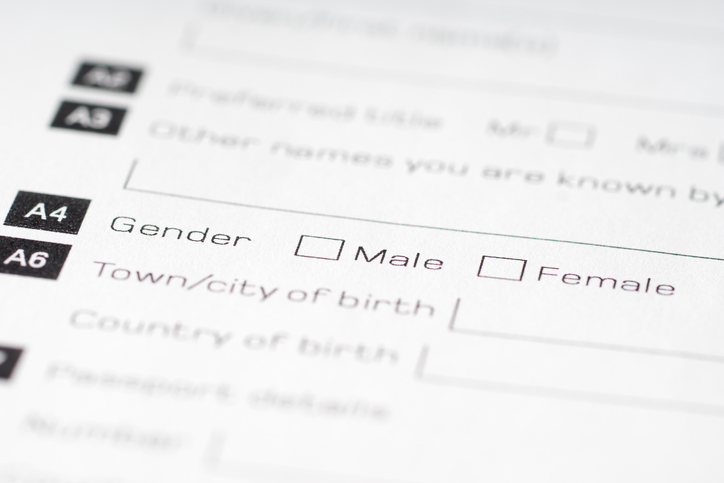Editor’s note: Terry Vavra and Douglas Pruden are senior partners at the consultancy Customer Experience Partners. Vavra is based in Richmond, Va. He can be reached at vavra@customerexperiencepartners.com. Pruden is based in Wilmington, N.C. He can be reached at pruden@customerexperiencepartners.com.
Author’s note: We begin with an apology. We’re unlikely to get everything correct in this article. But the very nature of our uncertainty around this topic highlights how important it is to begin this dialogue. We also don’t have a “rock solid” proposal for solving the issues we’ll bring up. We believe concerted attention is required by the marketing and research communities to better utilize the classifications of sex and gender in our data collection and strategic planning.
 It's the most basic demographic we use to better understand targeted customers’ responses to our products and services in the surveys we conduct. It's sex. Yet our traditional, simplistic, binary method of addressing it appears radically out of touch with the times. Our survey methods need updating. This is not only to improve our abilities to better classify the marketing intelligence we collect but also to be as respectful as possible of customers.
It's the most basic demographic we use to better understand targeted customers’ responses to our products and services in the surveys we conduct. It's sex. Yet our traditional, simplistic, binary method of addressing it appears radically out of touch with the times. Our survey methods need updating. This is not only to improve our abilities to better classify the marketing intelligence we collect but also to be as respectful as possible of customers.
As a result, we believe a review of the evolving gender landscape is critical for practicing marketing planners and decision makers. Our own awareness started with an article in Refinery29.com – a next-generation women’s media company with goal to “celebrate imperfections, banish taboos and always strive to be real and relatable.” The article reminded us of the importance of being enlightened and respectful of peoples’ sexual identities.
A lexicon of current sexual orientations
To update one’s understanding of the spectrum of current sexuality Refinery29, in conjunction with GLADD, offers 54 of the most current gender descriptions and terms. Here’s a sampling of the spectrum:
Androgyne – A person who doesn’t identify with or present as either a man or a woman and generally has both masculine and feminine qualities.
Aliagender (third gender) – Someone who defines their gender as ‘other’ than a man or a woman.
Bigender – Someone who identifies with two distinct genders, such as man/woman or woman/androgyne. Bigender people don’t necessarily identify with each gender 50% of the time, and unlike gender-fluid people, they don’t exist on a spectrum, either.
Cisgender (gender normative; gender straight, heterosexual) – Describes people who are not transgender. From the Latin prefix ‘cis’ meaning ‘on the same side as.’ The antonym of transgender.
Genderqueer – People who experience their gender identity and/or gender expression as falling outside the categories of "man" and "woman." They may define their gender as falling somewhere in between man and woman, include both man and woman, or they may define it as wholly different from these terms. The term is not a synonym for transgender or transsexual and should only be used if someone self-identifies as genderqueer.
Neutrois (agender, gender-fluid, non-binary, genderless) – An umbrella term used for people who do not identify as either a man or a woman.
Transgender (adj.) – An umbrella term for people whose gender identity differs from the sex they were assigned at birth.
Transsexual (adj.) – An older term, originated in the medical and psychological fields. Still preferred by some people who have changed – or seek to change – their bodies through medical interventions (hormones and/or surgeries).
Trans – Shorthand for both transgender and transsexual.
A primer on sex classifications
As our understanding of the complexity of sexuality increases, so too does the onus placed on the researcher to fully anticipate needs as addressed by any question dealing with sex or gender. Falling back on, “we’ve always asked it … that way” has never been a good rationale for including a question in a survey. Questions to accurately classify sex demand far more precision from the questionnaire author.
The Center for Diversity and Inclusion at the American University has published a statement on gender, sex and sexual orientation pertaining to surveys and data collection. The statement attempts to distinguish between sex and gender, two categories it claims are frequently misused in surveys. Here is a look at the Center’s definition of all three categories:
- Sex refers to one’s biological make up (chromosomes, hormones and primary and secondary sex characteristics). This is often represented by SAAB – sex assigned at birth.
- Gender identity refers to the internal/psychological sense of self, regardless of what sex a person was assigned at birth. Gender identity is not visible to others. (Other sources include a fourth construct, gender expression – open expression/demonstration of a person’s gender identity.)
- Sexual orientation refers to a person’s emotional, physical and sexual attraction toward others.
 Applications to survey research
Applications to survey research
Our overview suggests we, as social scientists wishing to be respectful in our outreach to our customers, are subject to a greater responsibility when addressing a demographic like sex – previously considered so simplistically binary. Nowhere is there opportunity for greater disregard than in the way we address sexuality in our demographic screening. There is substantial discussion in the way sexual orientation and gender identity should currently be assessed.
Consider what the American University’s Center for Diversity and Inclusion suggests when writing questions related to sex and gender:
- When asking about sex as a category, words like male, female and intersex should be used.
- When asking about gender as a category, words like woman, man, transwoman and transman should be used.
- When asking about sexual orientation as a category, words like gay/lesbian, bisexual/pansexual, heterosexual and queer should be used. Please note that homosexual is not recommended as it is often used in a pejorative tone.
An issue which must be addressed, to remove this discussion from a purely ideological dialogue, is which aspect of an individual’s sexuality has more influence over their behavior as consumers, their gender identity or their sexual orientation? While gender identity and sexual orientation may both have an impact on consumers’ acts and purchases, we argue that gender identity is likely the more overriding of the two constructs. Gender identity, the gender or genders that control a person’s deeply felt internal experience of gender will likely be more important to the product and brand choices a person makes, than sexual orientation (the type of individual to whom a person is sexually attracted).
Here are several different current procedures for advancing the sophistication of the gender identity question:
- Extended lists (a 2016 survey by the British tabloid, The Sun, offered a choice from among 25 classifications).
- Sequenced, hierarchical process (following suggestions from SurveyMonkey.com):
- What is your gender? Female, Male, Other (Specify).
- Do you consider yourself to be: Heterosexual (straight), Homosexual, Bisexual, Prefer Not to Answer.
- Do you consider yourself to be transgender? Yes, No.
- Gallup two-step method:
- What sex were you assigned at birth, on your original birth certificate? Male, Female.
- Which of the following terms best describes your current gender identity? Woman, Man, Trans Woman (male-to-female), Trans Man (female-to-male), Non-binary/Genderqueer.
- Johns Hopkins Medical Center questionnaire
- Your sexual orientation: Asexual; Bisexual; Choose not to disclose; Gay; Lesbian; Pansexual; Queer; Questioning; Something else; Straight (not lesbian or gay) – You may select multiple options.
In dramatic contrast, the 2020 U.S. Census asks, “What is Person 1’s sex: Male; Female?” About which the National LGBTQ Task Force observes, “Like many surveys we fill out, the Census restricts the responses to this question to ‘male’ and ‘female’ only. Unfortunately, this question fails to acknowledge the myriad of sexes and genders that exist.” The Task Force reports it’s working to change that for future Census surveys.
Looking forward
Laurel Westbrook and Aliya Saperstein, in a paper dedicated to rethinking the collection of sex and gender in surveys, suggest three considerations:
- Surveys should consistently distinguish between sex and gender.
- Surveys should rethink binary categories.
- Surveys need to incorporate self-identified gender and acknowledge that it can change over time.
While some of the sex and gender extensions we’ve identified will, admittedly, apply to only a small percentage of one’s customer base, it is still appropriate to demonstrate sensitivity by providing a wide enough range of response categories to make respondents comfortable that their individuality will be accurately recorded. As with all things, change and evolution are to be expected. Our measurement of sex as a major classification variable for the information we collect must accordingly be kept fluid and current.
Sources
Brabow, Kasandra. “54 gender identity terms every ally should know,” Refinery29.com. May 31, 2019.
The Center for Diversity and Inclusion, American University. “Inclusive survey and data collection practices concerning gender, sex, and sexual orientation.”
Fiske, Robert. “Are you a demi-boy or gender fluid?” The Sun. January 28, 2016.
Laura Wronski. “Why (and how!) to ask survey questions on sexual orientation and gender identity.” https://www.surveymonkey.com/curiosity/ask-survey-questions-sexual-orientation-gender-identity/.
Westbrook, Laurel, and Saperstein, Aliya. “New categories are not enough: Rethinking the measurement of sex and gender in social surveys.” Gender & Society, Vol. 29, No. 4, pp. 534-560. August 2015.
